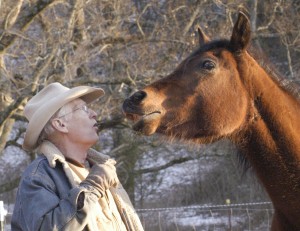Training with Treats

The latest contribution from our friend Joe Camp.
I’m not a professional trainer. I do not do it for a living. But I am a student of what works. Logic and common sense to a fault, I suppose. Which lead us quite unexpectedly to the discovery that horses can develop a vocabulary.
Yes vocabulary!
Horses can learn the meanings of words and, like children, as their vocabulary grows they can put those words together into different phrases and sentences. Even actual conversations. That’s not supposed to be true according to most, but Kathleen and I have found it to be absolutely true. And now there is even a scientific study proving it. Words help!
But why, I’ve been scolding myself, especially after decades of working with our canine superstar Benji, did it never occur to me to use verbal vocabulary with our horses, or to expect the horse to be capable of rational thought. I suppose it’s because so many of the trainers and clinicians we studied at the beginning of our journey eschewed the use of words and preached that we should stick to body language.

They felt the same way about training with treats. So why would we fly in the face of virtually every trainer I’ve ever been exposed to who are all in lock step on the subject. Use treats minimally, and never as a training device they say in unison. But when we discovered that training with treats seriously enhances and speeds up communication; and for the first time it gave our horses a way for them to speak to us, to initiate conversation… that’s when everything changed. With traditional training, we humans are always the ones doing the talking. Telling the horse, one way or another, to do this or do that. Never do we ask or listen to what the horse might want. And for the most part we teach with negative reinforcement. Release of pressure. In other words we stop doing something that is uncomfortable for the horse when he does something we’d like him to do. And we call it a reward.
Positive reinforcement would be something that the horse considers… well, positive. Good. Desired. Even fun.
Whoa! Hold on there. Have we stumbled onto something that actually teaches the horse and the horse enjoys it, thinks it’s fun?
Yes, we did.
Fun is a key word here because once basic natural training – what I call leadership training – of a horse has begun in earnest, after the horse has been given the choice of whether or not to be in relationship with us, the work is all about maintaining leadership and relationship. And learning to communicate what we’d like the horse to do. So much typical training is based on the horse’s genetic desire to be safe and comfortable that the usual learning process is heavily slanted toward giving the horse the choice of either doing the behavior or being uncomfortable. Like the simple request asking the horse to lower his head. It’s either lower it, or feel the discomfort of halter pressure on top of your head.
The horse learns. There’s no pain or cruelty. But not much reasoning either. And not a whole a lot of fun.
At no other time, other than perhaps a frolic in the pasture, do we ever get to see the horse having fun. Especially while his brain is engaged and he’s learning.
Fun?
What’s that about?
Most folks grow up assuming that the horse’s capacity to reason and his ability to have fun are just not part of his genetic make up. And unfortunately those subjects just never come up.
Didn’t with us.

We never really thought about it. I was so focused on becoming one of the herd, using their language, directing them away from the reactive side of their brain, teaching them to move their various body parts as Clinton says, “backwards, forwards, left or right” – all of which is absolutely necessary to establishing a positive relationship with the horse, and necessary to clearly establishing my leadership role, which in the herd is based upon who moves who – that it just didn’t occur to me that a horse could grow into reason, much like a dog can reason. Or that the horse could develop a verbal vocabulary, like Benji. The caveat is that all the basic training must come first, because neither reasoning nor vocabulary will occur until the horse trusts you enough to stay on the thinking side of his brain, and respects you enough to choose you as a herd leader. And until you have lived up to that leadership role this means working from the horse’s end of the lead rope first. Understanding and using his language, and the way his herd dynamics work.
Without that there is no opportunity for communication in either language, his or ours. With or without vocabulary.
Only when he knows that you understand his language and he has accepted you as his trusted leader should you offer him the opportunity to now understand your language. To play the way you play. To learn the way you learn. Only then can he feel secure enough in his trust in you to truly embrace and understand these new ways and new things, and give himself fully to the effort.
But give himself he will.
My Cash learned to smile in about thirteen seconds, and now he uses it to start a conversation.

Might I have a treat please?
Never does he become a pest, nudging, digging into our pockets. He merely asks very politely with his smile. And he understands that no is an answer.
We have a routine that we follow when, for example, we’re at the end of a session and Cash asks for yet another treat. As I mentioned above, words, once learned, can be linked together in different ways, different phrases, even sentences and actual conversations. This is a terrific example of just that. Say we’re wrapping up a session and Cash lays his big toothy smile on me.
Just one more treat. Puleeze!
I’ll usually harrumph a bit, and then say:
“Well… alright. Just one more. Okay? Just …one …more.”
Another big smile.
I give him a treat.
And he actually turns and walks away.
Conversation over.
And it always leaves me smiling.
Cash also bows, both with me and to me. He waves with one foot and no matter which one he waves with first will switch when asked to wave with the other foot (actually understanding the concept of other). He flexes laterally, touching his rib cage on both sides, with no halter or lead rope. With the word up he’ll raise his head,,, or lift his lip higher if he’s smiling… or his leg if he’s waving. He understands the words walk with me, down, move, out, go on, come, back up, go sideways, and more.
All taught when he was completely at liberty, using treats.
And all so much fun for both of us.
See more in our new eBook Nugget from The Soul of a Horse: Training with Treats.Only 99 cents on Amazon and Barnes & Noble.
Or visit: www.thesoulofahorse.com/EBN-TrainingWithTreats.html
Joe Camp is the author of the national best seller The Soul of a Horse – Life Lessons from the Herd, The Soul of a Horse Blogged – The Journey Continues and his new series of eBook Nuggets from the Soul of a Horse. He is also the creator of the canine superstar Benji and the writer-director of all five Benji movies. For more visit www.thesoulofahorse.com
